A Reunion to Remember
Maratha Light Infantry
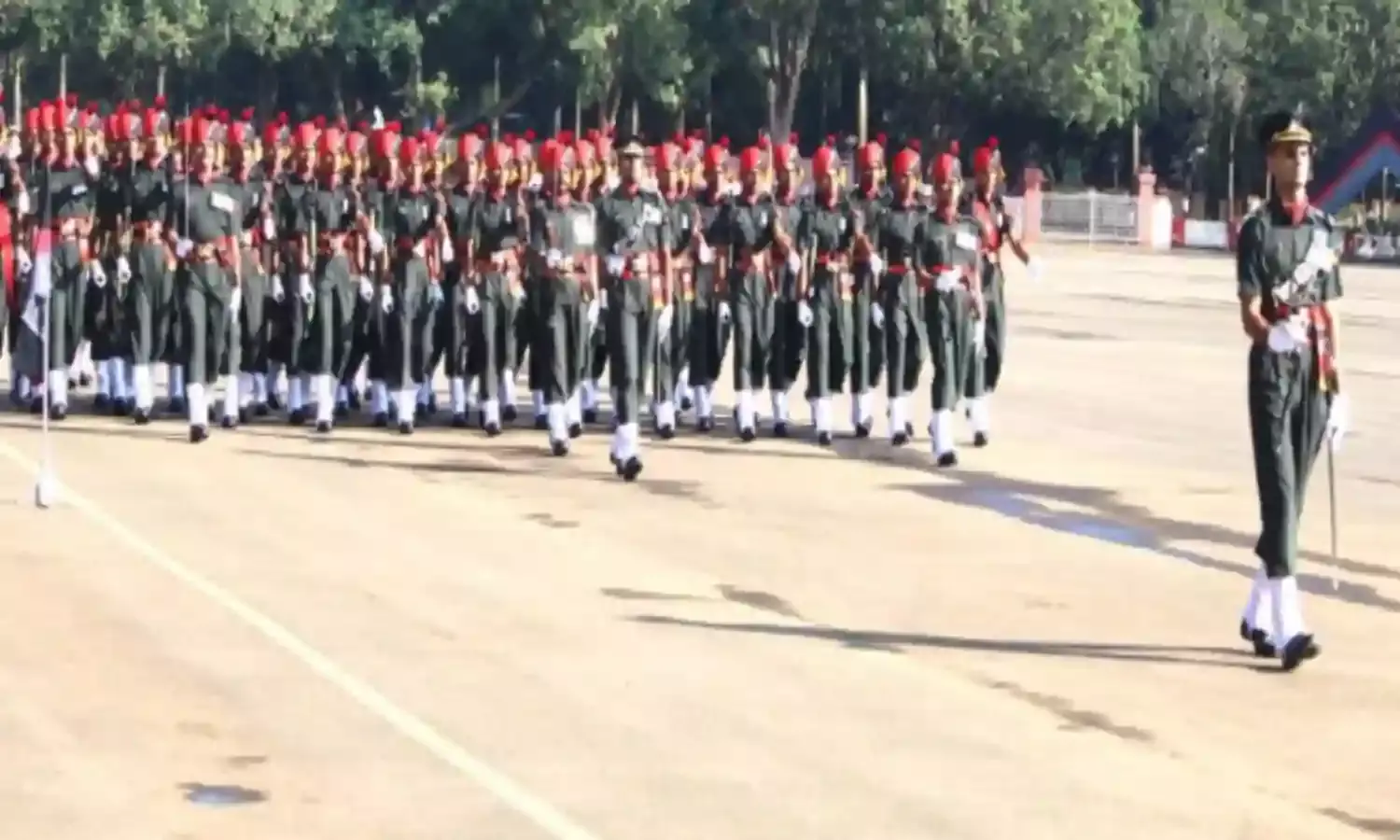
Reunions take place all over the world, at varying levels. These may be between two or more individuals who have not met for a long time, or formal or informal groups meeting on a fixed schedule, or even at a hastily convened meeting. Irrespective of the type of meeting, what draws individuals to reunions is to bond together with friends, relatives, colleagues and more importantly, meetings between comrades to recall past events and remember others who could not attend due to health or other reasons or those who have departed permanently to another world.
In the Indian Military, especially the Army, Reunions have special significance on account of meeting and assessing the old timers and the new comrades who have been tied to those mystical organisations known as battalions and regiments for decades and centuries. These Reunions are formalised, and Army Headquarters has set up rules for them. Broadly, Reunions can be held after four years and Army Headquarters sanction is required to hold them.
In my Regiment, The Maratha Light Infantry, we have had Reunions regularly. While the format is designed to ensure that all participants get maximum time to interact with each other, each Reunion programme and more so content of each event differs. This adds to the anticipation of all those who attend and indicates that our Regiment does not lack talent and new ideas; this is also an indicator that we have all ranks who approach situations with a fresh mind and are dynamic in nature, which are great battle-winning factors.
All this and more were visible in this Reunion that was held from 15 to 17 October at the home of our Regiment, viz. the Maratha Light Infantry Regimental Centre, Belgaum in Karnataka State. The number of guests that the Regimental Centre handled is mind-boggling, as it was just short of the 1500 mark and included all ranks and families, plus local invitees. The age group of veterans was from late Eighties/early Nineties to the late Fifties, not counting young dependents who had accompanied their parents.
Before I write about the main events, the less informed need to know that a Reunion is conceived, after frequent discussions between the Colonel' of the Regiment ', who lays down policy and broad directions and the Commandant of the Regimental Centre who implements these policies and directions to the minutest detail, with selected staff from the Centre, comprising all ranks, usually called 'Team Reunion'.
The third person of note is the ubiquitous Subedar Major Sahib of the Regimental Centre, who is always available, albeit hardly visible, as he runs the events like a well-oiled machine. Those who are from the Army know what all goes into producing the final product, which is no less than superb.
In our case, these worthies were Maj Gen K Narayanan, 'Colonel of the Regiment'; Brig Joydeep Mukherjee, Commandant Regimental Centre; and Sub Maj & Honorary Captain Salim S, the senior most JCO of the Regimental Centre. Incidentally, he is from 18 Maratha LI, the battalion I had the honour to command.
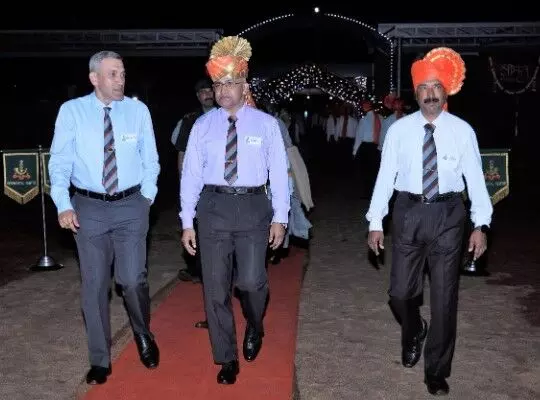
A word about the large number of senior officers from the Regiment and others who had attended this Reunion. Lt Gen KS (Bulbul) Brar was obviously the senior most. His late father, Maj Gen Digambar Singh Brar, OBE, was the first Indian 'Colonel of the Regiment' (1949-1959). Except for two past 'Colonels' of the Regiment, Lt Gen MA Zaki (1987-1992) and Lt Gen Asit Mistry (2019-2021), who could not make it, there were four -Colonels' who did, plus three more who had been 'Colonels' of other Regiments. I was the senior most, although General JJ Singh outranked me; he is also an Honorary 'Colonel', by virtue of being a former Chief of Army Staff.
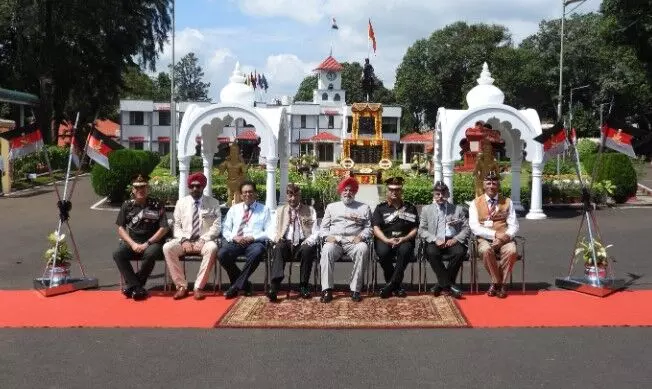
'Colonels' of the regiment in front of the war memorial
The brief visit by the present Chief of Army Staff, General Manoj Pandey, accompanied by Mrs. Pandey was the 'cherry on the cake' and a rare occasion. It was greatly appreciated by everyone, especially because they are such a gracious couple, who made it a point to mingle with everyone.
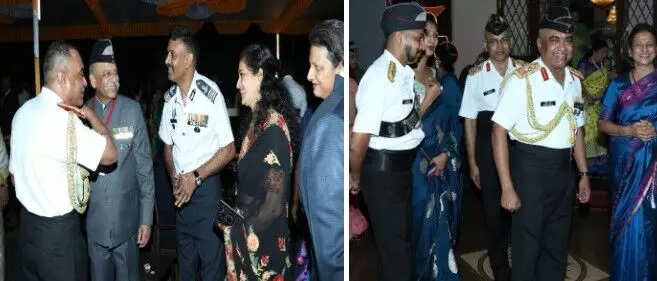
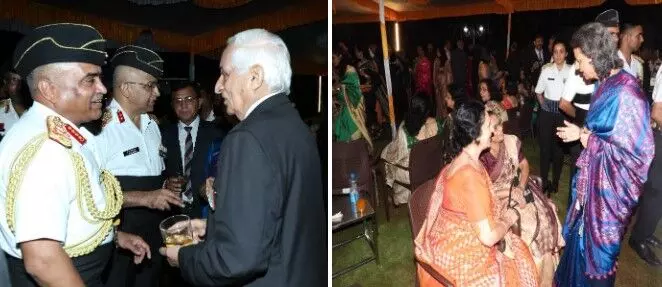
Others who attended were all ranks from Lt Gen to Major, but we did miss the Mohites, the clan that has always had at least one member serving the Regiment continuously for over a century, in various ranks and at various locales, including today.
The present Maharaj of the erstwhile Kolhapur State and other Royals having close affinity with the Regiment attended various events, indicating their solidarity with the Regiment. The eldest son of the Kolhapur Maharaj, Sambhaji, who is now a Rajya Sabha member was also there, more outgoing than earlier, perhaps on account of being a Member of Parliament now!
I have no intention of covering in detail all the events that crowded the calendar over the two days plus of the Reunion, but the important ones need to be stated. It has been traditional to commence the Reunion with the Commandant hosting the Dinner at his residence, Maratha House, to enable everyone to renew past events and more importantly to see the changes creeping age has favoured on one and all. Our hosts, Brig Joydip and his charming wife, Mrinalini, as well as all the officers and wives posted in the Regimental Centre as well as the Records Office of the Regiment ensured that the evening was enjoyed by all.
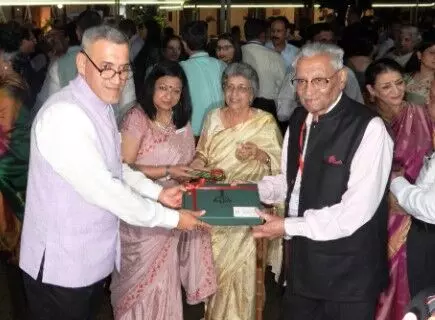
The main events commenced next morning with the Inter-Service Parade that was truly joint, for the squads consisted of not only troops of the Regiment, but also of other Affiliated units of the Regiment , which had been given to other regiments for the enhancement of the fighting capability of the Indian Army, viz. 3 MARATHA LI (2 PARA SF); 20 MARATHA LI (10 MECH INF); and 21 MARATHA LI (21 PARA SF).
Besides them, it was heartening to see contingents of other affiliated units, from all the three services, viz. 34 and 36 Med Regiments of Artillery; INS Mumbai of the Indian Navy; 20 Sqn IAF (Sukhoi); and Indian Coast Guard Air Station (Daman). The Reviewing Officer of this Parade, Lt Gen Ajai Singh, C-in-C Andaman and Nicobar Command was also appropriately chosen.
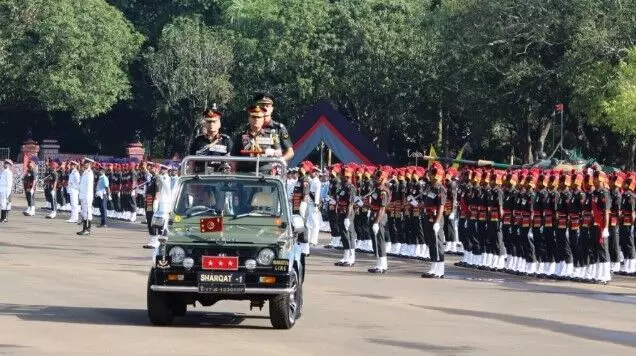
Perhaps the hierarchy at New Delhi needs to take a cue from the joint nature of this fine parade, which ended with a fly past by two Dornier aircraft of the Coast Guard!
After the grand parade, we walked up to the Regimental Quarter Guard, the pride of any army unit, formation, or establishment, where the solemn wreath laying ceremony was held. Wreaths were placed at the foot of the massive equestrian statue of Chhatrapati Shiva Ji Maharaj.
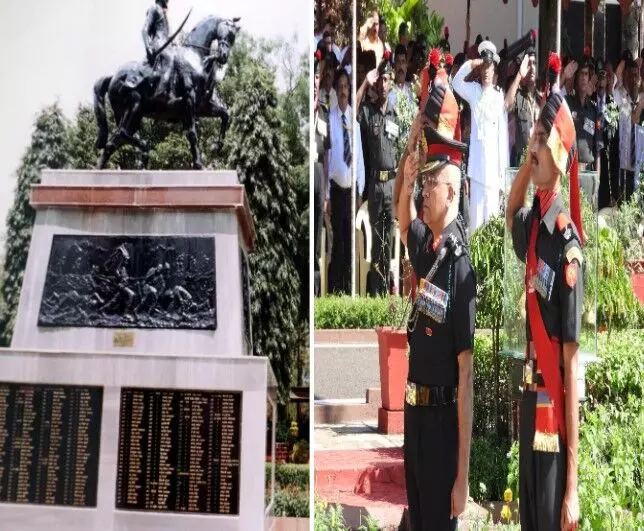
The honour of placing the first wreath went to the oldest veteran JCO of the Regiment, Subedar Major and Honorary Lieutenant Vasant Shedge. Lt Gen KS (Bulbul) Brar, former Army Commander of Eastern Command laid the wreath on behalf of all veterans of the Regiment. He was followed by Gen JJ Singh, Honorary Colonel of the Regiment, who laid the wreath on behalf of all former Colonels of the Regiment. The last to lay the wreath was none other than the current Colonel of the Regiment.
Attention then shifted to two shamianas facing the War Memorial, where Veer Naris and next of kin of gallantry award winners of the Regiment were honoured by selected senior officers of the Regiment, amidst thunderous claps from the gathering.
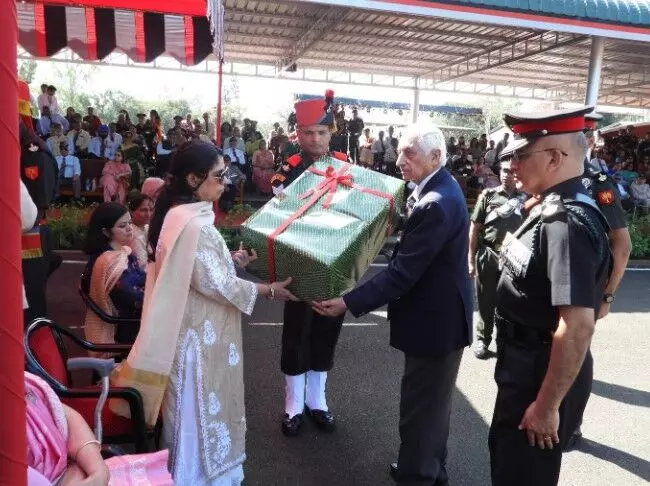
We then walked across to the Physical Training area for tea, refreshments, and inter-mingling. The ladies then peeled off for their Family Welfare Meet and we returned to the War Memorial for several formal photographic sessions, with the War Memorial as a backdrop.
The Special Sainik Sammelan, always an important part of the Reunion was held in the Boxing Arena, which was overflowing with serving personnel and veterans.
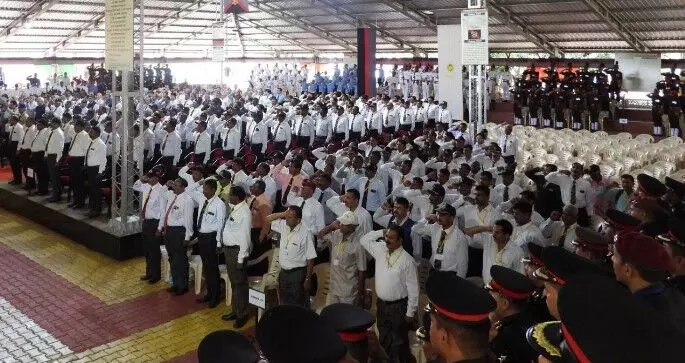
Besides the Commandant and the current 'Colonel' of the Regiment, senior officers and former 'Colonels' of the Regiment were also invited to address the huge gathering. The body language of the serving personnel exuded pride in the Regiment and professional competence, which were palpable, and we veterans loved it.
A visit to the Museum next door is always a high point of the Reunion, especially as one remembers our bygone times and a yearning to see new artefacts added since one's last visit. A new and most welcome addition was the self-worked digital programme pre-recorded and used with earphones that was released that day.
The lunch in the JCO's Mess gives a chance to all officers and JCO's to get to know each other in an informal manner; the difference this time was that the ladies too were invited, and we all lunched together in traditional thalis, containing katories full of regimental cuisine, with the Maratha Chutney, Tambda and Pandhara Mutton Rasas and Puran Polis having pride of place!
There were two major events planned by the Reunion Team for the evening, a cultural show cum searchlight tattoo: and 'Colonel' of the Regiment's dinner in the Officers Mess. A third unplanned one was added by the Almighty in the form of a heavy downpour, Belgaum style, just when the Army Chief, General Manoj Pandey and his charming wife reached the venue of the Cultural Show and commenced meeting the other guests.
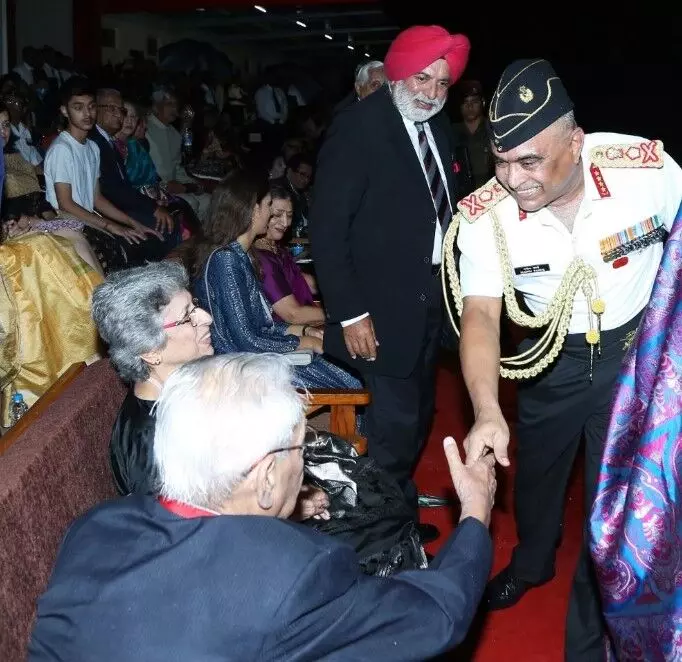
Although the helms of the elegant sarees of the ladies bore the brunt of the pouring rain, but it was treated as blessings from the Gods. The rain soon petered down and the cultural programme commenced. It was both traditional and military as the choreography merged the two seamlessly. Two episodes from that great Maratha Warrior Chhatrapati Shivaji Maharaj's life were juxtaposed with the gallant actions of Sepoy Pandurang Salunke, MVC and Col Vasanth Venugopal, AC, besides stand-alone events conducted by our serving soldiers and recruits with great gusto.
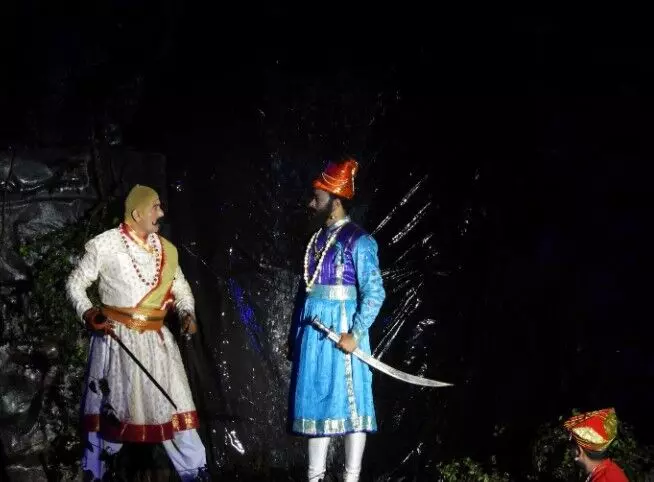
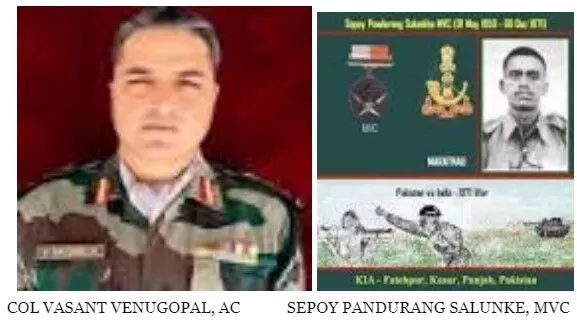
The Rain-God, Indra, having shown his might, refrained from blessing us with another shower and hence the dinner at the officer's mess was conducted with tradition and bonhomie.
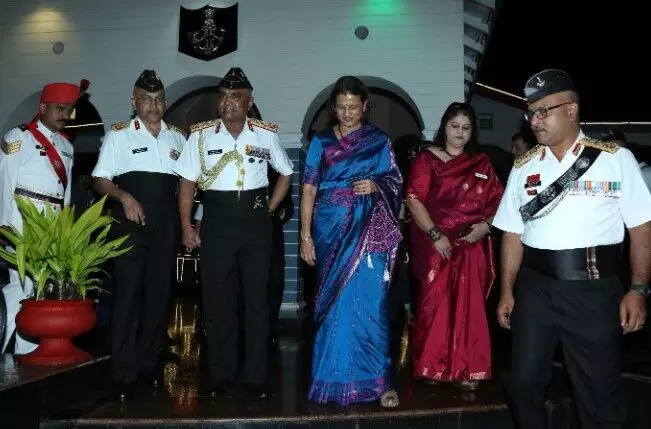
COAS and Mrs Pandey Arrive at the Maratha Mess AND MRS PANDEY ARRIVE AT THE MARATHA MESS
Among the various presentations and talks prior to the dinner, the Chief also presented a silver salver to the Regiment.
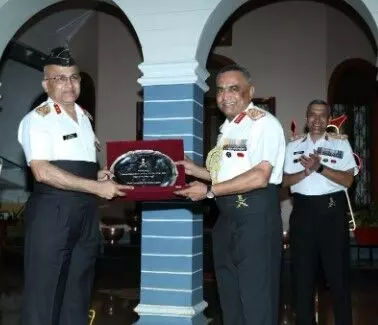
After the speeches and exchange of mementos, dinner was announced by the Mess Havildar, as it is always done with the well-known words: 'Bhojan Tayar Hai Shriman' spoken smartly and with the correct inflection; but the army is now told, 60 years later, to dispense with colonial symbols!
Such important events are remembered for a long time, as there are always mementos of the Regiment, which everyone carries home. The best memento of this Reunion, besides the warmth and hospitality that were all pervasive, was perhaps a replica of the Royal Seal that was minted by Shahji Maharaj, on the birth of his son, Shivaji, who later became the great warrior king of India and the inspiration of our Regiment: Shri Chhatrapati Shivaji Maharaj.
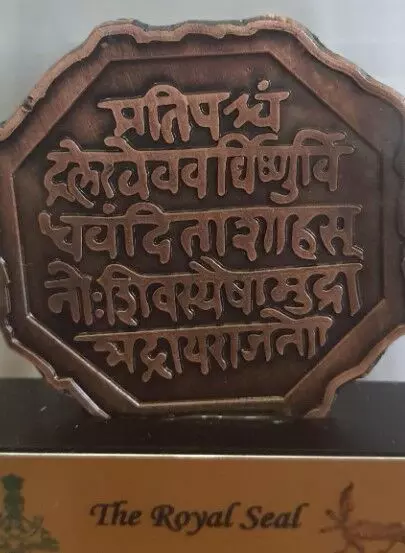
Rough translation of the Seal is: "The glory of this Mudra, honouring my son 'Shivaji' will grow like the first day moon. It will be worshipped by the world, and it will shine only for the wellbeing of people". Prophetic words indeed.
Having had a hectic day, the next and last day of the Reunion was both informal and filled with fun. After a meeting of the Regimental Association, everyone pulled out their most casual attire for the picnic lunch at a lovely spot not far from the Regimental Centre, where all types of goodies were laid out in many stalls, mostly serving street foods and a number of games available for the younger guests. If it were not for informal meets of serving and retired personnel of all battalions in the afternoon, the picnic would have continued. The rain Gods also helped with a quick shower, sending everyone running for their vehicles.
Traditionally, the finale of each Reunion is the Regimental 'Bara Khana', hosted by the JCO's and Jawans of the Regimental Centre, with the Regimental Subedar Major Sahib, or Bahadur Sahib as we normally call him, as the Chief Host. Subedar Major and Honorary Lieutenant Salim S, welcomed everyone in a short speech, delivered with aplomb!
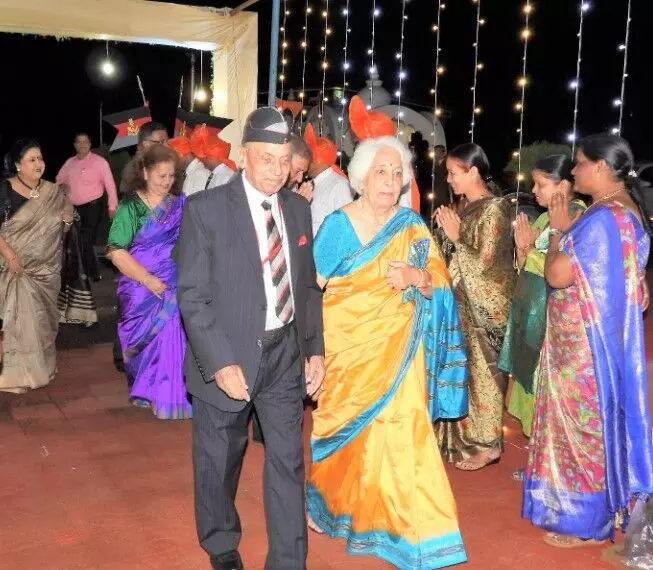
Brigadier Ranbir Aingh VrC and his wife being welcomed.
This was followed by a cultural show, especially choreographed for the Jawans and their families. Once again, it was juxtaposed with our culture and how young officers are taught about the finer points of the Regiment.
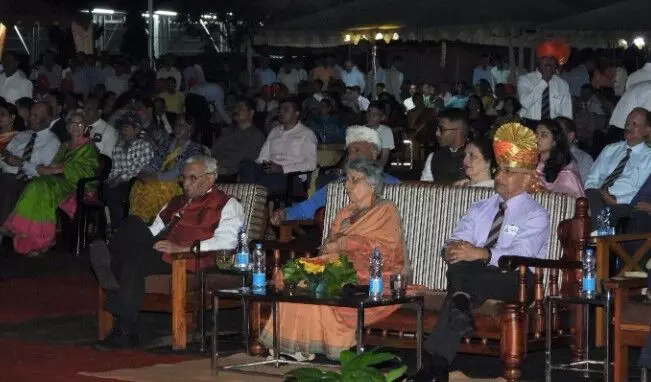
Cultural programme
It was a vast gathering with guests invited from all local units; all families of JCO's and Jawans; and officers and other guests from outstations. It was managed very well for it was a sit-down meal for everyone.
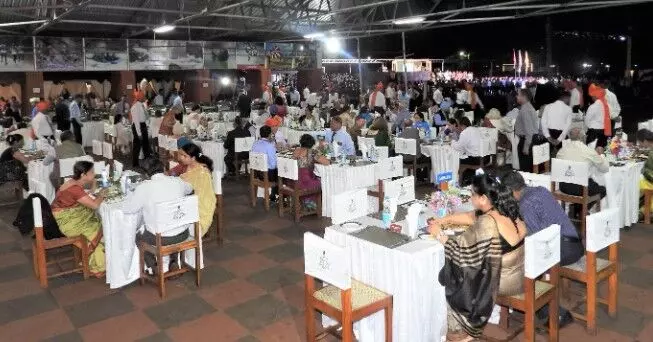
Those JCO's and Jawans who were on duty had been feted a day earlier so that no Jawan is left out. Being the last event of the Reunion, farewells were longer than usual, for four years is a long time, especially as none of us are getting any younger!
Throughout the Reunion, my mind had been dwelling on how the Regiment will fare with the unnecessary changes being foisted on the Army in recent months, like the so-called Agniveers and getting the Indian Military to shed its colonial trappings. While I have already expressed my dismay at the politically motivated changes in the time-tested recruitment in the Army and other services and the merits of Regiments, by those who have no clue about how the Army ticks and produces results, including in these columns; I searched hard to locate the so-called colonial hiccups that need to be discarded.
Here was an occasion where we saw, heard and felt the internal health of a large, one of the oldest highly proficient infantry regiment as well as the bonding with other components of the Army and the other two services, at every level from recruit to the Chief, but I failed to spot any colonial hang-ups. So, what is the fuss about; I would love to be educated. As far as I know, everything colonial within the Indian Military was discarded Suo Moto by the military hierarchy's post-independence, without being told to do so.
Perhaps the 'Darbaris' in the PMO and other Ministries need to take off their blinkers and look around at length and deeply, instead of just smelling the coffee and moving files, like the Sahibs of yore!
Lt General Vijay Oberoi (Retd) is a former Vice Chief of Army Staff.



